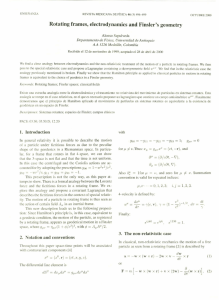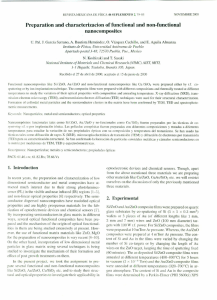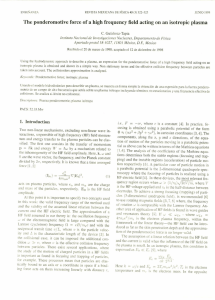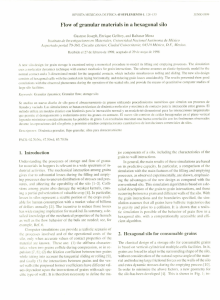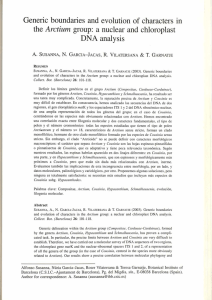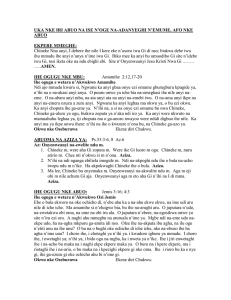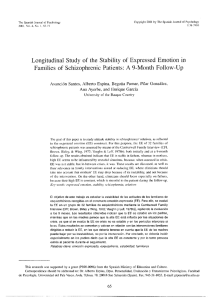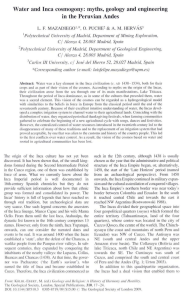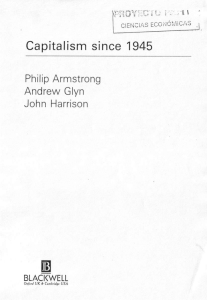The Coulomb problem and Rutherford scattering using the Hamilton
Anuncio
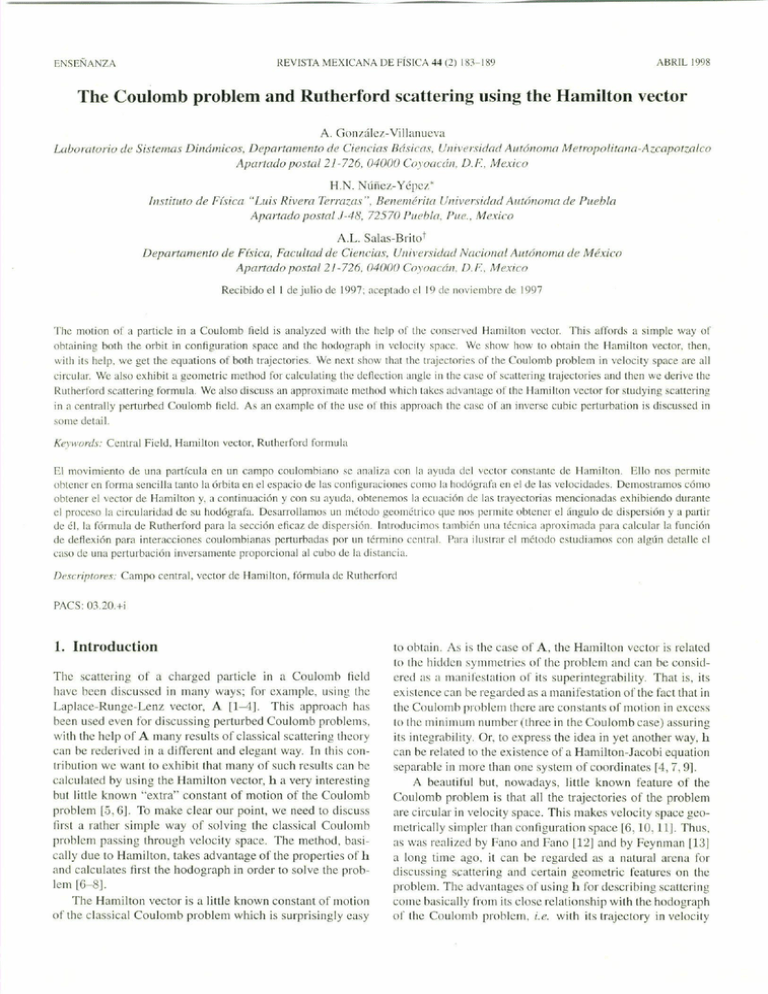
REVISTA MEXICANA
ENSEÑANZA
The Coulomb problem and Rutherford
DE FíSICA 44 (2) I R)-189
scattering
using the Hamilton
ABRIL 1998
vector
A. GOllzülez- Villanucva
La!JoralO";o de Sistemas Diná/1lico~.,Deparwme1/to de Ciencias Básicas, Universidad Autónoma MetroIJOlita1/a-Azcaporz.alco
Aparrado posta! 21.726, 0400n COYO(fc(Íl/,D. F, Alexico
H.N. Núñcz-Yépe/.*
Instituto de F(üca "Luis Rivera Terrazas ", Benc/IIérita Ullft'Cfsidad ,1lltáno/lla de Puebla
Apartado postal J-..f.¿;;, 72570 Pllc!Jla, Puc., Alexico
A.L. Salas-Britot
Departamento de Fúica, Facultad dc Ciencias, Uni\'ersidad Naciollal AIllÓf/Oma de México
Apartac/opostal 2/-726. 040(JO Coyoa('{íll, D.F, Mexic()
Recibido elide
julio de 1997: aceplado el 19 de novicmbre de 1997
Tlle molion 01' a parlicle in a Coulomb ficld is analyzed with the hdp (Jf Ihe conserved Ilamilton vector. This afl'ords a simple way (JI"
ohtaining both the orbil in configuration spacc and the hodograph in vclocity space. \Ve show !low lo obtain the flami1ton vector. lhen.
with ils help. we get the equations ol' both trajectories. \Ve next sllow lhal lile Irajcctories 01"the Coulomb problcm in vclocity space are all
circular. \Ve also exhibit a geometric method for ca1culating the dellection anglc in lhe case 01"~cattering trajectorics and then we derive the
RUlherfon.l scattering formula. \Ve al so diseuss an approximate mcthod which takes advantage of the flami lton vector for studying scattering
in a centrally perturbed Coulomb ¡kld. As an example 01'Ihe use 01"this approach Ihe case of an inverse euhie perturbation is discussed in
so me detail.
KeYlI'ords: Central Field. lIamilton vector, Rutherford I"ormula
El movimiento de una pnrtícula en un campo coulomhiano se analiza con la ayuda dd vector constante de Hamiltotl. Ello nos permite
ohtener en forma sencilla tanto la órbita en el esp¡lCio de las conllguracinnes como la hot.lógrafa en el de las velocidades. Demostramos cómo
obtener el vector de Ifamilton y, a continuación y con su ayud¡l. obtenemos la ecuación de las trayectorias mencionadas exhibiendo durante
el proceso la circularidad de su hodógrafa. Desarrollamos un mélodo geométrico que nos permite obtener el ángulo de dispersión y a partir
de él. la fórmula de Rutherford para la sección ehcaz de dispersión. Introducimos tamhién ulla técnica aproximada parn calcular la función
de dellexión para interacciones coulombianas perturhadas por un lérmino central. Para ilustrar el método estudiamos con algún detalle el
caso de una perturbación inversamente proporcional al cuho de la distancia.
/)cscriptores:
Campo central. vector de Hamilton. fórmula de RUlherl"ord
rACS: 03.20.+i
1. introduction
Thc
scatlcring
to obtaill.
oI' a charged
have heen discussed
in many
particle
ways;
in a Coulomh
I'or example.
f1cld
using lhe
Laplacc-Runge-Lenz
vector, A [1-4J. This approach has
hecn used even for discussing perlurhed Coulomh prohlelTls,
wilh the help 01' A many results 01' c1assical scalterillg theory
can be rederived in a different and elegant way. In this COIllrihution we wanl io exhibit that many of such results can he
calculated by using the Hamilton vector. h a very interesting
but Iittle known "extra" constant 01' motion of the Coulomb
problem [5, GJ. To make clcar our paint. we need lo disclIss
t1rst a ralher simple way af solving the classical Coulomh
problell1 passing through velocity spacc. The method, oasically duc lo Hamiltoll. takes advantage of the propcrties oI' h
ami calculates l¡rst the hodograph in order to solve Ihe probIcm [6-8].
The Hamilton vector is a little known constant ol" Illotion
01' the classical Coulomh problern which is surprisingly easy
As is (he casc 01"A, the Hamilton
vcctor is relalcd
to thc hiddcll symmctrics nf the problern and can he considered as a lIlanifcstation
01' ils supcrintegrahility.
That is, ils
cxistcnce can he rcgarded as a manifeslation
01' lhe I'actthat in
the Coulomh prohlclll there are conslants oI' molion in cxcess
to the lllinilllUm nUlllhcr (thrce in the Coulomh case) assuring
ilS integrahilily. Or, to express thc idca in yel another way, h
can be rclatcd to lhe existence oI' a Hamilton-Jacohi
equation
scparahlc in more (han olle system 01' coordinates
[4, 7, 91.
A oeautiful out, nowadays.
Iittle known I'eature of lhe
Coulomb prohlclll is that all the trajcctorics
01' lhe problem
arc circular in velocity space. This makes velocity space geo.
metrically simpler than configuration
space (6, lO, 111. Thus.
as was reahzel! by FallO ami Fano [121 ami by FeYllmall1l3]
a long time ago. it can he rcgarJed as a natural arena I'or
discllssing s¡;attering ami certain geomclric
I'catures on thc
prohlclll. Thc advantages nf usi ng h for descrihing scatlcring
come oasically frolll ils close rclationship with the hodograph
01' the Coulomh prohlem. i.e. \Vitil its trajectory in velocity
IS~
A, GONZÁLEZ-VILLANUEVA,
Il.N
NÚÑEZ. YÉPEZ. AND A.L. SALAS-BRITO
.Vy
,
h
F[(;URE
2.
Thc Coulomh
prohlcm
hodograph
is always
a cln:lc
ccnlcrcd al h and with radius 101/ L. In Ihe case shown hefe Ihe
(lfig.in 01' cooruinalcs
in vej¡)ci[y space ( ,'-origEn) is inside the h(I,..1lIgraph,
<
i.I'. \Ve h,l\'l' j¡
Inl/ L
amI [!len E("
ChOSCll 11 :lnd hCllCC Ihe VL'loci[y
y-dircc[ioll.
This cnrrcsponl1s
space orienteJ
particular
FIGURE
l. Thc coordinare
systcms
uscJ
lo describe
rhe prohll'llI
are illuslratcd. The .:-axis points olltside ol' lhe planc 01'lhe papcr
anJ Ihe .r-;\,is gocs through hOlh lhe ccnler oC force al lhe origin
(rmrkl'd O) and lhe pcriccntrc orlhe orhit. A hypcrbolic scaltcring
lrajcclory
is shown lOgclhcr
wilh thcir <lsympto!es
(lhe thin strnigbt
lillL'S). -no anJ +80 are. respectivel)'. lhe angles thallhe
ami lhe oulgning
asymptotcs
makc wilil lhe J'-axis:
lion ;lngk and it is dcar Ihal £,/'2
+ (JlJ
incoming
= 11".
h
=
o.
In Ihis seclioll \ve derive lhe vector COllslant knowll as the
Halllilton Ve(lor, h. \Ve will dis(llSS hm\' to use it to ohlain
Ihe l'quation 01'thc orhit ami to show lhallhe prohlcm 's hodograph is a (irele or a eir(lllar are.
To hL'gin with. let liS consider the cqualion of motion nI' a
particlc in an ill\'crse squared licld lixed at the origin
n •
el"
1/f-;¡¡¡ = ,.2
( 1)
\\'herl' /11 is lile Illass. C,' thc unil vector in the radial dircction, l' the position vector nI' Ihe r¡¡nicle ami (\ is a collstanl
(l1araclcri/ing the intensily of the inlcraetion-for
Coulomh
inleraclioll \Ve should han~ n
qq' rl7r(o. The angular moIllClllUlll. L = l/Ir x v = II/r:1(}(~z = l.cz amI lhe CIlL'rgy E
are cOl1slaIHSof mol ion as in c\'cry central f1cld proh1l'rn. \Vc
11;I\'c"I..'lcctcd Ihe .l'-lj pbnc as lhc orhilal planc, R is lhL' parlick"s angular veloeity ami we use a eylindrical coordinatc
syslClll in whieh the polar axis coincidcs with the .r-axis and
passes lhruugh hOlh Lhe cenler of force and lhe poi nI 011Ihe
orhit closL'r lo it. as Fig. 1 i\luslrales.
Using the elementary rcslIlts Óo
-Hc". iJ
L/II/"'!.
ami angular 1ll0lllentum conservaLion in Eq. (1), where C/i is
=:
=
¡;;
<
(1. \vc havc
VI" poiming
in [he
orhit in cOllliguratioll
coincides
E = E,. ==
orbít in conliguralion
2
_'1I0
The
with lhe hodograph
/'2L'2)
corrcspnnds
lo
space,
10 f\. in lile dircetion 01' incrcasing
Ihe unit vector orthogonal
H. \Ve gel
,Iv
,11
dco
l/In
(2)
-T -;¡f'
111-
2. The Hall1ilton vectnr and the Cnulnll1h
prnhlell1
=
[o all clliplic
<
\vilh i[s Illajor axis along lhe .,.-axis as shov.'n.
(j.e. \vhen
a circular
pcricclllrc
case in \vhich Ihe I'-llrigin
E. is Ihe dcllcc-
spact.'. This happcns sincc a dassical scattering proccss,
\\"helllhe-re cxist asymplolk siates as in Coulomh's case, has
mainly 10 do \Virh lhe rcialiollship bctween the asymptolic
illcoming amI the asymptolic oulgoing velocities [3].
(p.I'
centre
¡J[
it is no\\' very easy lo dcriVl.' a ne\\' consLan! 01' 1Il0lion ror the
Coulomb problelll IG. 11, 1:,1. Ihe so-cal1ed Hami!toll v\:clor
h
=
v
+
n.
(.1)
T.e(/.
It is \\"orth nOLing thal h . L = () amI lhat. in conliguralioll
spaee. h poinls along Ih\: s\:l1lilalllS rcctllm of Ihe orhiL ¡,t'. it
is necL'ss:lrily parallt.:110 Ihe \'elocity al pericenlre Isec Eq. (6)
helowIIG]. In the coordinatc syslcl1l illuslrated in Fig. 1, the
lIalllilton vector points along tllL' .11 axis: It = '1 lly. \Vc can
now L'xpress lhe VL'hll..'ilyas Ihe SUI1lof the constanl vcclor h
plus a rotatil1g \'CeLor with cOllslanll1lagniLUdL':
\' =
IJ -
f./1
"
L;
(4)
Ihe rotaling componenl of Ihe "clociIY is always perpendicular lo r. This L'l]uaLinll lllL'ans Ihal '-Iny L f:. () trajectory in
vclocity space is a L'ircle 01"radius In 1/ L ccnlcrcd al b, T!lis
is illustrated in Figs. 2, ~. <llld 4. Curiollsly. as c\pressed
in a l"L'cenl hook 1111. "Ihis startling rael-Ihe
cin:ulariLy nI"
tllL' hodograph-is
unknown to most physicist" llL'spite ils
Illany impliealions in holh lhe physks and tlle geomeLry of
¡he Cllulomh prohlem [llJ. 11. I(il.
Thc Hami1ton \'cclor h l"ontains lIlost oí' Ihe dynamic informatiolllll1lhe llloLioll [,-). I (JI. ror e\<.lInplc. it is elemclllar)'
lo ohtaill the polar componen!s 01 the n~locily and their dl'pL'lldencc on H.
I',-(O}
=V'l\ = " sinO.
{'oU}) =v.¡.o
=
J¡('o:-ifl-
Z.
TIIE ('(lULO~1B
PROBLEM AND RUTlIERFORI)
SCA1TERING {JSING TIIE IIA:-'IILT()N
From Eq. (5) alllllhc
.V,
IX,
VECTOR
l:xpression
=
1'(1
r(J, (he equation
of
Ihe mhit I"ollo\\'s illll11ediatL'ly:
1"
.x
o
'V,
F](;UI{E 3. ¡flhe I'-origin :-itsonlhe hodograph. ¡.l'. ir/¡ = Inl/L.
E = (J and ( = l. Ihe nmliguration space orbit is the parahola
:-bo\\"l1. In Ibis case the /'-origin represents Ihe asymptotic vclocitics at inlinity: v
=v
(J.
+')U
-00
=
=
/'
Inl...;H-sgn(l'
((, )
\\.heh.' s!.!n slands for lhe si!.!nLlIllflltletion (s2n.r = 1 ir.1' > tl
or sgn.l~ == -1 if.1' < ()).\~'e han.' detincd 1; == L ~/mlnl ami
( == LI'/lol. Equalioll ((1) is ohviously Ihe polar cqualion 01'
a conic seclioll wilh eccenlri<..-ily f and scmilatus reelUIll JI;
lo complelely charac(cril.e the coni;.: section we have lo la"-e
into accoullt Ihe algchraic sign 01' (\. It is wonh pointing OUI
the silllplil'i(y nf lile process 1'01'getlillg Ihe gt:ncr<.ll rorlll lit
the orhil \1,:iIIlIIlL'help 01' h.
Nolice thal expression (5) implics Ihal the vclm:ilY at pericentre, likL' h. p()illts in the y-direction.
Although it is il1lplicit in IIlL'delinitioll nf" il L',m he lIscfllllO
the Illagnilude 01 h can he \\Tittt:tl as
1, == (-.
emphasi/,e
thal
[ni
L
011 the othL'r hand. Ilntice lhat the energy 01"lhe motion can
hl' expresscd in tet"lns 01"11 in Ihc a1ternativc forms
, 1I1(~
L=-
.y
.,
h
I:urthertlltlre.
h
j{
•
'X
'1 --.,
,
o
:.!
--
o~)
2
1/10 (,
=--(
[.2
the f:UlHlIls Laplare-
he easily ohtained
-l. )
2L~
RlIngc-Lenz
(X)
vector [:~I can
as
¡'!)
;\=hxL=,,'-xL+oi~¡.:
r
o
f¡
Ihe conslallcy
o!" A !"ollows as a simple
conscquenee
01"(he
conslancy nf h and nf L.
\Ve can now sho\\' lIsing Eqs. (4), (6) and (8), lhal lile
type 01' llloliol1 changes according lo where the origin 01' coordinales
(h)
(a)
in veloeily
space is located
in relation
lo Ihe hodo-
graph 1(;.1111:
the p-origin is outside the hodograph, l.e. ir 11 >
hodograph isjust the dark circular are
hOllnded hct\\"l'en lhe angles -00 ami +fJo. where co~O(J = 1/(.
Notiee thallhc wilole l'irclc corrcspollds lo Ihe two hranehcs of Ihe
hyperhola. The 1\\"0 rossihle cases are shown: (a) The allraclive
case (\ < O. where the hodograph is concave tO\vards the origin
Thc asymplOtic velocily vc<..-Iorv_= makcs an angle ~fio (or. as
showll ami equivalentl)'. :In :Ingle Ti - no) wilh the .r-axis. In this
l':ISt' Ihe cl'nlre lIf forre sits al the inlernal forus 01"lhe contigllraliorl sparc hypcrhola. The lighl dashcd curve sho\\"n in f-ig.. tl
(anú in -l.b)nnn,:spolllb lo the brand pf Ihe hypcrbola nol aCluall)"
travCTscd. (h) The rcpulsive C;;lSC(l > O. where Ihe hodograph is
C\11l\'CX
Iowanls thc origino Thc asymplOtic vclocit)" veclor v +::>.
makes an angle +00 (or. equivalently, an angle (Jo - ir) \vilh Ihe .1":l\is, as shown. Thc ¡;elller nI' I"on..'eis localed al lhe external fOl'll:of ¡hl' hyperhob. This figure is son 01"Ihe rc\'erse of Fig. -la.
a) If lIJe hodograph cenlre coincides wilh Ihe origin or
cOOl"dinates in veloL'ily space, ¡.C. il""
O, the con1iguralion
space mhil is also circular ami lhe hodograph is lile who!e cirele. In this case, as I'ollows fmlll (H).l:~ El' == -/l/o'.! /:.!L'.!.
where ",. and /'0 are, rcspcctivcly,
tlle radial and al.imuthal
l'<lI11pOnenls 01" Ilw vellll'ily and
is Ihe l11agnitude 01' h.
Tht:se are Ihe paralllelric
t:qllations 01" i.I circlc in veloL'ity
space; so, as \Ve claimcd he I"ore, the hodograph is a circlc
or circular arc-depending
on (he rangc allowed rOl"o.
grapll is [lol the whole L'ircle hUI jusI a circular are-the
are's
1imiting <Ingles are fOlllld solving lhe cqualion ('osHo
I/f;
(Jo is tlle incidenl angle (Fig. 1). Thc conliguration
space 01"hil is I1Yllcrholic il1 lhis case. /\llolher faL't worlh (Ir lIlCtl~
liolling !lL're i....llll' cPlIlpacliliGllioll
aehievcd by inlroducing
F((jURE
-1-. Ir
1(11/ fJ, E > ():lIld Ihe \\'hole
=
=
Ir Ihe OI"igin nI" c()orl!in:lles
is insidc Ihe hodograph
hUI does
In 1/
nol sil 011 its ccnlcr. ¡.I'. ir"
<
L. \Ve IllUS( have
E,. < E' < (J. IIlL' hodograph is also the wholc circk and
the L'onliguralion space orhit is an c1lipse. The former case is
¡¡ panicular
instance of the Ialel'. Sec Fig. 2.
h) 11'the origin 01' eoordinales in \'clocity space sils on Ihe
= 101/L
hodograph, f.C. if '/
there is a point with asymplolic~lIly vanishing velocily. \Ve havc E
ami the houograph
is again the wholc eirele. In this case the orhit in configuration .space is;\ p~\rahola. This is illllslraled in Fig. 3.
c) Ir (he origin nI' coordinares in vcloeit)' spacc is olltsidc
lhe hndograph, ¡.l'. ir 1/ >
L, we Ilavc E > (J, tht: hodo-
= n.
1/.1;
'1
R(,l'. Ml'x. Fís. -W(2)(1()t)XllX:\-lXl)
=
IX('
A GONZÁLEZ-VILLANUEVA.
H.:'\ NÚÑEZ-YI~I'EZ.~\NDAL. SALAS.BRITO
Ihe hodograph: Ihe wholc infinity trajectory in conliguralion
~P;[CL'is mappcd lo Ihe I¡nite circular are 01' lhe hodograph.
Fig. -la ¡Ilustrales lhe case (}
lhe L';[SL' (l > O.
< () whcrcas Fig. 4h ¡Jlustrales
In lhe resl 01" lhe arth.:1e \ve assulllc tha! lhe conligura'pace orhit is a hypcrhola as corresponds lo a scatlcri ng
lrajec\ory. \Ve also aSSlJlllC tha1 lhe scattcring occurs in a rcpul"in; (n > O) Coulomo licld-according
10 (6). only hypL'rholas :lre allo\\'cd as solutions in such a case. NOlicc also
Ih;lI. as Ihe dcnominalor
in (6) mus! be 1l00Hlcgalivc, ir ( > 1
¡hl' only orbits allO\vcd are Ilcccsarily conlincd hc\\vCCIl lhe
1l01l-IlUI1anglcs -Ho and +fI(). Thcsc <lnglcs are lhe dirccliollS o!"the asymp(o(es or lhe l1yperbola. or, respectively. 01'
t!ll' incoming. V_ex-. and outgoing. v+=. vclocilies. In Ihesc
nllldilions. (he ex ternal foclIs of lhe hyperhola coincides with
Ihe n:J1Ier 01' force as shown in Fig. 4b.
I jI III
\Vc llave illuslraled !low Ihe unpcrturhed Coulomh prohkili l'an he snlvel! wilh lhe help 01"11.To c{Hlclude lhe sCl'tion,
!l'1 LISpoint oul Ihal altlloLlgh \ve have j"ound Ihat the numhcr
or cons(ants in lhe prohlcm is 7 (m e\'en lO. in \Ve include lile
cOlllponents 01' A) namely, lhe energy. plus (he lhn:e eompoI1l'n1S01' L. plus the lhree cOlllponenls 01' h, onl1' :; constanls
oul 01' the original 7 can he indcpcndcnl 191. olhcrwise the
sySIl'1Il \\'ould he O\'erde(ermined [.11. Thc existencc of 5 indqK'ndcnt constanls 01"mol ion is descrihed hy saying Ihat lhe
prohlcm is superintegrable [7, IGI.
\
\
\
\
v.,
o
FHillJ<l5.
Tlle Coulomh prohlcrn hodograph in the rcpulsivc case
(C()lllp,lrC wilh
Fig. 4h).
It is casy to ser that lhe im:idcnl
and de-
¡lIlgks <In: rclated hy (Jo + ~/'2 = 11"/2. It is aisll l'asy In
sce frolll simple geornelry that ~v....., = 2ec><> Sill(~/'2)i~,rand that
(n/L):lt'¡I = -(2n/L)silllJot~_r.
tlcct¡on
in Fig.:'.
As a resull oflhe scatlering.lhe
~,.~, =
.~'V
velocil1' changes in
e
\'+~, -
V
=
IX;
"
_1''Xl.'"
2'
.in .....il.r.
(11)
ilnd (he lInit angular vector changes in
~t~(/
J. Scatterinl(
Rutherford
in a Coulomh
formula
field allll the
In Ihis scclion we shO\v ho\'.' lo use h <Iml lhL' hodograph 10
dcri\"l~ the RUlhcrford sCi.lltering formula. Thercfore. in this
sl'clion :lIld in the resl or lhe anicIe, we assulIlc E > () and,
hencL'. that all mbils are hyperholie. Por convenience \Ve also
assumc that n > O. although lhis is nol slriclly necessary
SillCL'thL' discussion is also applicable, wilh minor changes.
10 lhe case n < O.
In Fig. 5 (which is hasically lhe hodograph showll in
Fig. --lb) the l)uantities perlaining (o scatlering are clearly
depiclcd. \Ve lhus infer lhat. using h and (he hodograph.
il should he very casy lo compute lhe deflcction angle t.,
ilnd hence that Ihe RuthcrfonJ formula rOl" scatlcring in a
Coulomb tield musl also follow using lhe slandard Illelhods.
In lhe diagram (see also Fig. 1) il is clear lhal Hn and t. are
rL'lated hy f)o + t./2 = Ir /'2. For ohlaining the appropriate relalions bClwcen such quantities. let us nole that. as the
11;lIniltoll vcctor suffers no changcs during the mol ion, ror lhe
whok scaltcring lrajcclory (as rol' any part of il) we ought to
=
t~1/
=
(+CXJ) - l\¡( -('))
-'2 Sill B()c:r•
(
J
2)
during lhe whole process.
Equations (11) and (t 2) rol~
low. lIsing simple geomctry. from Fig. 5. l\loreo\'t~r. "ince
~/:!.+ 0(1 = ¡;(!. \vc havc co:-; (é/':.) = :;in 80 ando hy plllgging reslllts ( 11) anu (12) inlo Eq. (10), we gel
"''' =
2
(,,=
sill ~
-7;
ens~)
e = O.
Thellce. \..•.
e see lhal L ami (he incoming specd.
Iatcd hy lhc so-called RlItherford relation
L
=
(l.')
T
VOQ'
arc rc-
e
(l
-cot~.
( I~)
'2
{'oo
From lhis l'xpression, it is iml1lcdialC to get, in lhe standard
way. lhe dilfcrenlial sC:lltering eross section in a Coulomb
ficld [:\1
d"
rHl
=
1
/II:!"~
I Sill~
L
dL
d~
I= (
n
'2lJlV~
)'
1
Sill,I~/2'
(15)
This is RUlhcrford's differentinl scattering cross seclion,
which haprens lO he independent of the sign of n. lhal is,
in (15) i( docs nol malter whethe!" lhe inleraction is rcpulsivc
or altractivc.
hah'
Li.h
= .ó.v'X)
+
(\
.\
~
-L.l.eo
L
= O.
( I O)
\\hcre IhL' change .ó.en is evaluated hy subSlracting lhL' incoming from lhe oUlgoing angular unit vector. as illustrated
4. Scatterilll( in a perturhed
Coulomh lield.
In l!lis sL'ction \Ve ¡lIuslrare Ihe value 01"Ihe Hamilton vector
descrihing scaltering cvcn in a perturhcd huI slill cenlrnl
ÜH1I()I11bpn)hlem.
rol'
Rev. Mex. Fú. 44 (2) (19()X) IXJ-IX9
187
THE COULO~1H PR.OBLEM AND R.UTHERFORD SCATIE1W";(j lJSINCi TllE HAl\lILTO:-': VECTOR.
11'Ihe perturhing
f(r)
terl11 has Ihe ronn
=
J(")(\"
the
el)Uatioll 01' 1ll0tiOll hecornes
(16)
Dcspite (he facl that in Ihis case is no longer conserved, the
11allli 1t<1I1vector is sti I1 use fui for doing cerlain scaltcring calculalions.
In Ihis seclion we discuss Ihe prohlem following
Ihe ideas presented in Ref. l. hlllusing 11inslead 01' A.
\Vhen a perturhation
is present lhe equalion of Illotion 01'
Ihc Hamiltoll vcctor [13 J follows from (3) ami (16)
dh
-dt =
It is lIscful lo transform
tirst, it is ohviolls
f(,.)
•
v,
( 17)
--el"'
111
(a)
(17) to a difrerclltial
equ01tion in (J.
y
tha!
dh.
-11
di! '
dh
di
nexl, lIsing Ihe conservalion
dh
-=
di!
(1 X)
01" L. frotll ¡his follows tlwt
B
,."f(,.) •
---e, ..
L
( 19)
x
Although in principIe Eq. (17) can he integratcd along Ihe
scallering trajectory lo get Ihe change in h, Ihis is 01' no use
(unlcss we do it nUIllerical1y) since we do nol kllow the 11'01+
jectory from the start. Ho\Vcvcr, El). (19) can he lIsed to get
a lirst order approximation
to Ihe trajectory valid whcn (he
pcrturhatioll
1(1') might he rcganlcd as slIlall 12,14]. l.e. if
11(1')1
in the rangc 01" r-vallles importanl ror Ihe
scaltcring proccss.
An explicil il1uslration 01' the use 01' Ihe
criterion is given in lhe next seclioll.
Let LIS aSSlltlle Ihe ahoye criterioll is met; so. let LIS inlegratc Eq. (19) along the unpcrt[Jrilcd scallering trajcctory. to
FI(iU({E (1. l~olalj(l1101' a sC<lucringtrajcclOry umkr a conservalivc
gel
cl'lltral pcrturhatinll_
« ni"'!.
áh
=
=
. ¡.oo r"f(,.)cosBdi!+
C,
L.-vo
. ¡.o" r"f(,.)sillBdi!
"y
L._
oI1
(110 ,."f(r)cosBdB.
t!J
L .
(20)
-00
=
=
Since h
1/ éy t!len h.6h
O; in l!lis way, \Ve have cxplicitly gol that thc change in h is orlhogonal lo itsclf. As
folhm!s from v~
¡,:! - 02 L!., this result "Iso implics that
=
I
=
O. That is, in Ihis approximalioll,
although the
aSYlllptolic vclocity changes, il only rotales hut never modities ils length. Thus we can say lhal lhe pcrturhation
proVtXI
•
t1v(X;
duces a rotation 01' h in Ihe scattcring planc hy an angle givcn
hy t.an ó~= JI, h, but, in lhe approximation
\Ve are working
wilh. tall ó~ := ó~.since we aSSlllllC ó~
1. Tllat is, as a IIrst
appro.xilllation,
we Illay rcgard h as just lJlldcrg~)ing ti c1ockwise rolalion--eounlcrclockwisc,
in the case nl":ln attractive
perturhalion-hy
an anglc óJ¡ 11. Bul this can he casily inlcrprcted as a rolalion of the incoming antl outgoing as)'mplotes
by l!lis angle. Thus Ihe wholc proces may he dcscrihcd as a
I
«
I
H('\~ ,\kr. 1"/.\. ~
(h)
Thc pcrturhing force is asslltllcd rcpuLsivc.
fur the sakc 01' clarity. the resulrs 01' Ihe pcrturhatioll have hern
cX:lgerall'd, (a) Schcmalic ferrcscntation of thc dfccl of a (..-entral
n:rulsivc ({'I > O) pCrlUrhalioll on lhe hodograph. Thc l\vo. onc inl'Olllillg ;llld llll' utiler olllgoing, auxiliary Coulornh likc hodographs
arc ShOWllas ligll! dashcd cirdes shiftcd lo each olher hy ¡)h. Thc
aclual hodogr:lph 01'lhe pcrturhed prohlelll is the darlo;.curve shown
inlerpolalin¡! hl'lwcell Ihe allxiliary hodographs. (h) 'fhe corl11g.
uraliol1 SP;ll'l' orhils COfrcsponding lo Ihe hodographs illuslraled in
Fig ...b, The auxiliar)' Irajeclories are shown as dashed light curves.
,\ amI B lllark. rcspccli\'c1y. Ihe Jllxiliary incoming and Ihe auxiliary olllgoing Irajeclories. Thc so lid d:uk curvc cOfresponds lo [he
aclual pcrturheLl orbit. Thc straight lincs s!lown are lhe asymptolcs
01'lhe au:-:.iliaryIrajcc[ories.
cOlllhinalion
01' two
auxiliary
Irajcl:torics:
an
incoming
auxiliary
ÜIUIOlllh-likc
trajcctory
plus :lIlolher auxiliary
Coulolllh-like
olllgoing trajeclory
which llave lo appropriakJy "interpolaled"
in the middlc to construcl lhe approximate Irajeclory uf lile perturhed proOJcIll. AII uf l!lis is illustrated in Fig. 6 \vith hOlh con1iguration
space orhils ami
h(ldographs.
(2) (19()~) IXJ-I~9
IXX
A. GONZÁLEZ-VILLANUEVA.ILN
NÚÑEZ-YÉI'EZ, AND A,L SALAS-BRin>
I11cntioncd ahoye are just an approximair Ihe pcrturhing force J(1') is rcasonahly
smal!. 11is intcrcsling lo note lhal the approximatiolllfcatcd
hefe call cvcn dcal \vith lhe slrong huI shml rangc nuclear
forces. \Ve only !leed lO guarantcc a distanl collision proccss
fOL in slIch a case. c\'cn lhe nuclear intcraction may he COI1AII lhe rcsults
(ion lo Ihe proccss
sidcrcd
to Ihe Coulomh
as a pCrlurhation
force
¡:n
1'.
I
1'.
Undcr
slu:h condilions ami ir lhe pcrturhation
is rcpulsivc. ¡,l'. ir
> O. \Ve have argued (har lhe del1cctioll angle incrcascs
f(r)
hy
á~amI
"
so it hccolllcs
FIC;URE 7.
pc:rlurhcd
= :! arceol
e
\I,hcn:
Coulomh
(Ll'-,,-oo)
+ -l
lOO
Lit .
Ahsolulc
Coulomh
vallle
nI' Ihe dctlcction
flcld calculatcd
amI in Ihe lirsl-on.1cr arrroximation
,.2 f(,.)
('os
ede;
(21 )
-00
dark
lindo
pcrturhcd
Thc ah ...olull'
<Ingle in a
1/7'."-
(conlinuolls dark l¡nc)
discus ..•cJ in lhe le\1 Ida:-.hcd
cxactly
valuc nI' (he L1cllcction angk'
Clllllo111h case (continuous
I¡gllt curve)
in Ihe un-
is also stul\'.'n túr
Tlle angles are in L1cgrccs. The valucs llscd for (he
wcrc E = 2. (l = l. 111 = l. anLl
¡1 = O.O:!;:)in arhitrary units. 1. i", also in afoilrary uní! ...
l'tllllparison.
refers 10 lhe dellcction
anglc in lhe unpcrturbcd
case. which can he ohtained frol11 Eq. (14). This
c.\prcssion
can be uscd
firsl-order approximalions
as the starting poinl for deriving
to the dilTerential cross section ror
paramcters
nI" ¡he prohlcrn
also cxprcssed
as
sOllle scallering prohlcms.
To illustrate Ihe Illcthod, in Ihe
ne.\( sectioll we discuss scatlering in a Coulomh f1cld pcrlurhed hy a l/r;~ inleraction.
5. An example: scatterin¡: in a r-3.perlurhed
Cuulumh field.
To illuslrale
what we !lave heen discussing,
let us selccl Ihe
=
explicit forlll 1(1')
,6/,.3, \!"'here {3 is a conslant. for Ihe
pCrlurhation. This te fin makes Ihe perturhctl problem exaclly
solvahle [17], hUI even (his is nol rcally a complete advantage
(2~)
wherc we are assllllling
that L ami ¡:; lake Ihe same
C<lSL'can he approximated
as
hccausc Ihere is llO \vay of inverling lhe solution for gctting
t::xplicil expressions ror L as funclion ol' ~ antllhus neilher for
calculating exactly Ihe dil'ferential scattering cross section.
This kiml of lrouhle with 11solvahle cxample just conlrihules
lo illustrate the usefulness orthe approxilllate Illcthod. On (he
olher hantl. lhe perturhation
selected allows the dircct comparison of lhe approximate
expression ror ~, calculated wilh
the IIlcthod ol' lhe prcvious seclion, wilh Ihe exacl resull calclllaled in lhe Appendix.
\\'ith lhe explicit expression
ploying Eq. (6) as ¡he Coulomh
for the pcrturbation and, elTl.
solution ,.(e), we gel for ¡he
rolation angle
1
111..
6~ = -
--13
hLp
JOO
13
-80 l'
JOO
(,cose -1)cosede,
(22)
-00
or. clTecling lhe elementary
integration,
1'25)
1\ comparison of this approximation
ag~linst the exacl result
is shown in Fig. 7, where \Ve plot. as il is lIsually done since
an expcriment JUSI dclecls Ihis. Ihe ahsolulC \'alucs of lhe approximate dellcction angle Eq. (25). the ahsolule \.alue 01
Ihe exacl dellectioll <Ingle [calculaled
in Ihe 1\ppendix, seL'
El). (1\3)1 amI. ror purptlses of comparison,
Ihe del1eclion allgle for lhe ullperturhcd Coulomh case 121. As YOll can sec in
Ihe figure. Ihe approxilllalion
is rairl1' good sa\"e al lo\\' \'alHes uf L (sal'. lür l. < (l.:~;l). Ihal is. onl1' if the Irajeclory
COfIles close to the center 01' force, hUI even so. il reprodw:es
Ihe Irend in the hchavior 01' E,.
No\\', lO compute the changes
-cos8d8
we ohtain
(23)
o
in Ihe Ruthcrford
diffcr.
ential scatlering cross section prodllced hy (he presence 01'
the perturhation
we only need to appl1' lhe standard formula
given in (15). Ho\Ve\'cr, as expression
(25) is r¡¡ther diflicult 10 invert for getting l. as a fUllclion nI" E,-sincc
~r also
dcpends 011 L-we
use <llltllher apprtl<ldl which lakes advalllage of the smallness 01" 8E,. To this end. lel us wrile ror lhe
perturhed
this resull shows thal the dcl1ection angle increases when
/3
>
and that the outgoing angle (Jo dirninishes
by
600 = -J(/2. The change in ¡he oel1ec¡ion angle (23) can he
vallles
as in lhe 1I1lpcrlurhed Coulomh case-as
it is cas)' lo real in:.
this is always possible withollllosing
<lny generality. Thcm:e.
according lo Eq. (20), the dellcL'lÍoll angle in the perturbed
Jillercntial
drT
dO
Rev. Mex. Fis. 44 (2) (1998) 183-189
CfOSS
section
(26 )
TIIE COULO~m
PRüBLE~l
,\NI) RUTIIERFORI)
189
SCAITEI{I:--:C USI:--:G TIIE 11r\\1ILTON VECHlR
Ihe clTecl 01"the perturhation can he estimatcd by jusI po\Vcr
expanding (2ú) and laking lhe absolule value 01" Ihe reslllt 1:21
iC¡¡lel!In Ihe ll1emory nI' our bcloved fricnds F. Ek, Q. Tomi.
f\.1. GIlIckhen. M. tvli/lon. M. t'vlina, B. ~\ilillina. amI M.
~lolila.
(27)
whcrc. at it is no longcr important, we have removed lhe sub~
scripl (' and. as hcfore. \Ve assullled that Illere is no changt.:
in Ihe angular 1ll0lllentum, This expressioll. \vhich may be
asslImed cOfreclto llrst order in ó~, can be regardcd as Ihe
dilTerential scatlering cross scction in a Coulomh ficld perlurhed hy a ,.-:~ lield, Notice that, as il \Vas lo he expcctcd.
Ihe perturhation losses effectivily on increasing lhe projecIile's angular mOlllentllllllcompare with Ihe lirst 01"Eqs. (24)
alld lakc a look al Fig. 71. That is, the approximalion is hctlcr
Ihe farther from Ihe ¡¡cid Iravels Ihe projeclilc.
Appendix
The only purpose of Ihe appendix is 10 derive lhe exacl formula rOl"lhe ddlcclion anglc in lhe Coulomh prohlem perlurhcd by an invl'l"se cuhic term. The cffeclive potenlial enl'l"gyror lhe pcnurl1L'd problem reads
n
{j
L2
= - +:--,., +;;--:>.
.
(,//(r)
,.
_1"-
(Al)
~IIII"-
Ihcrcforc, accortling 10 Eq. (18.2) in Rcf. 2, lhe dellection
angle can he calculaled as
Acknowledgments
The work has hcell partially supportcJ hy CONACyT (granl
L~.DP-E9ó07). The Fundación Ricardo J. Zevada has PI"Ovided Ihe funds ror adquiring lhe software in \\'hich Ihe figures \vere dr:m'n. \Ve also wanl to thank K. Hryoltiy and (j.
Candelila ror lheir very lIscflll cOlllmenls. This papel' is dcd~
I
t.
=
ir -
:2 arcsin [
//lo:.!
JI + 2E(U
L/r2dr
J2m(E
\\here rl, = ,,(1 + JI +2E(U
+/hll)/11Io2)/2E
is lhe
dislancc In pcrkclllre inlhe perturhed prohlelll. Effccling Ihe
integral in (¡\2) wc gel
]
+ l1rd)
. [
2E(U + mi!)
- :! ;lITSlIl --,----------============+
11102
+ '2E([,,2 + /l/In + VII/o2(1/1f12 + '2E(£2 +
whcre E = 1I/11~/:2. This is Ihe exact cxprcssion ror lhe delk'clion angle in the perturhed Coulomh prohlem. In Ihe case
/1;::: O. El!. (A3) can he shown lo reduce lo Ihe Coulomh cxpression. In Fig. 7 \\'e compare Ihe e.\act formula (1\3) wilh
•. On s3hhatical h,'avc from Departamento de Física. UAi\.l-l/ta-
UA\l-AIClp(lllalco
2. CE.
Aguiar
ami t\1.F. Barroso.
Am..J. Phys. (.4 (\996)
101M2.
+ 2E(U + JlI¡J)
!l. ;\J.\\'. b'ans. 1'''-r.\. Un: A -tI (1990) 5666.
A!1I1/i. ¡\foll/J¡ly l)O (19XJ) 353.
111,
11. .\1.C GUl/willer. C"llO.~ill C!ax.úcal amI {jucl1Irum.\feclulIIin.
;\CW York. 1990). p. IlW.
1'2. lJ. FallO ami 1.. FallO. !Jasic PJ¡ysics (1Atoms (11/(1Molende.l.
(Wilcy. Nn••..
York. 195X) Appendix 111.
[:\. D.L. Goodslcin and 1.R. Goodslcín.
.1. R.P. :-'1anínl'/-y-Rolllcm. 11.i\'. Núñe/.- Yépcl amI A.L. SalasBri!o. EllrJ Phys. IJ (1992) 26.
1.1. J. Si\'ardicrc./:'III:.1.
11.Goldslcin. AmJ
1'J¡ys. +t (1976) 1123.
¡f.N. NúflCl-Yépcl.. amI A.L. 5:11:1<;I1rito. 1:'11/:.1. 1'J¡ys. 17 (1996) I ()R.
i. R.P ~brtílle/-y-R(lmcro.
H.N. Nlíñc/.YC:PC/, amI A. L. Sala~Brilo.l:"/f/: .1.1'''-'".\. l-t (1993) 71.
H.rs:. Núñe/-Yc:pc/. A.L. Salas-Ihilo.
1. Phn'. 1(, (1995) 220.
1:'1lr.
/l/o(ioll
(~r/}/(/II('/,\'
I.~). D. \lnreno.
lIl"{nmt!
I"l'
h'YIIIIW/I'S
,\"/11/.(Norlll11.
Nl'w
los( In/uH'.
York.
¡//I'
Il)l)(ll-
I'''y.\. IJ (1992) (}4.
(i"(/1'illlciúfI
¡\'ell.tor¡ÚIlW. (FCUJ'\A\l.
~lé\ico
City. 19(0).
G. A. GOIl/:ík/-Vilhlllllc\'a.
S. O. Campu/;lllo-Cardona.
and G.1. Sáncho-Orti/.
(A,)
,
the IIrst order expression rol' t. given in Eq. (25). we also plol
lhere lhe delleclioll angle ror Ihe unperturhctl Coulomh rl"Oh~
lel11.
.1. L. Landau and E.~1.Lifshitl, Med/ll/lic.\'. (!'l'rgamoll. Oxt"md.
1976). Chapo IV.
.1.
]
.,
1
(Springcr.
Am.l. Phy.\". -tK (19RO) ..tOO.
11I (\-
mo2
1/1/1))
10. J. \lilnor. A
palapa
t. On ~ahhatical ka\"c fmm Departamento de Ciencias B~ísicas.
l. 1.. Bas<lno ami A. Bianchi.
(A2)
- U•.//(r))'
1(,. ;\,1.. Salas-Brilo.
Romero.
IUS:. NlíñCl-Yépel..
!t1/1. .1. ¡\forl.
allu R.P. \1artíllCl.-y.
PI'.','\". i\ 12 (1l)()7) 271.
(~r
A ¡"c(/Iis(' 011 rhe {//Iolytic(l/
dnwmio
/,arlides lIIul rigitl bodin. 4th ~dition. (C.lInhridgc Uni\". Pr~<;s.
C;lInhrid~~. 19X' 1;..•.6. p. 83.
17 E.T. Wllill:lkl'r.
He\'. Me.r. /.1\. -t-t (21 (1991:-1)IX3-IX9
».
